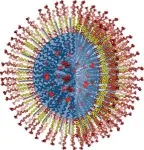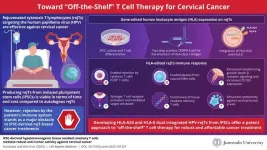(Press-News.org) Aortic aneurysms are bulges in the aorta, the largest blood vessel that carries oxygen-rich blood from the heart to the rest of the body. Smoking, high blood pressure, diabetes, or injury can all increase the risk of aneurysms, which tend to occur more often in Caucasian male smokers over the age of 65.
“The soft tissues that make up blood vessels act essentially like rubber bands, and it’s the elastic fibers within these tissues that allow them to stretch and snap back,” says Professor Anand Ramamurthi, chair of the Department of Bioengineering in Lehigh University’s P.C. Rossin College of Engineering and Applied Science. “These fibers are produced primarily before and just after birth. After that, they don’t regenerate or undergo natural repair after injury. So when they become injured or diseased, the tissue weakens and causes an aneurysm, which can grow over time. After about seven to 10 years, it typically reaches the rupture stage.”
During that period, there is no treatment. Patients are screened regularly via imaging to monitor the rate of the aneurysm’s growth. Once it’s deemed big enough to potentially rupture (an occurrence that is fatal 90 percent of the time), surgery is the only option. But it’s a risky one for elderly patients.
Ramamurthi and his team are working on minimally invasive ways to regenerate and repair these elastic fibers using polymeric or biological nanocapsules, called nanoparticles, that are designed to release novel regenerative therapeutics. Their innovative techniques could enable treatment soon after an aneurysm is detected and potentially slow, reverse, or even stop its growth. Findings from their most recent paper, published in the Journal of Biomedical Materials Research, build on their earlier work and represent a step toward a future where surgery is no longer the best, and only, treatment option.
“In previous research, we’ve identified drugs and gene-silencing agents that can actually coax adult diseased vascular cells to produce new elastic fibers and inhibit the enzymes that break down existing fibers,” he says. “We’ve also been working on how to deliver these therapeutics efficiently only at the site of tissue repair.”
The team has also developed a nanoparticle design called active-targeting that incorporates small protein fragments, or peptides, on the nanoparticle’s surface. “These peptides recognize components that are unique to the aneurysm tissue. So when the nanoparticles are injected into the bloodstream, they stick only to the aneurysm wall, where they slowly degrade and release the drug.
For this paper, he says, the researchers “investigated how the nanoparticles actually penetrate the blood vessel wall to deliver the drug to the affected tissue.”
All blood vessels are lined with a protective barrier made of endothelial cells, which can become “leaky” as inflammation from tissue damage or disease breaks down the endothelium and creates gaps between the cells. These gaps allow white blood cells to move in and start the tissue repair process, and they also serve as the entry point for nanoparticles that accelerate healing.
“We wanted to know how the shape and the aspect ratio of these nanoparticles affect their ability to cross that endothelial cell barrier,” says Ramamurthi.
It was a critical question to answer because not all nanoparticles are created alike, and if they can’t penetrate the barrier, they can’t repair the tissue.
Ramamurthi and his team developed a novel cell culture model in which they simulated disease and then examined mechanisms of transport: specifically, how nanoparticles of different kinds interacted with endothelial cells and moved through them. Did they enter through gaps among the endothelial cells (a process called extravasation) or through the cells themselves (what’s known as translocation)?
“Let’s say a nanoparticle goes through an endothelial cell. Some of it might stay within that cell and not come out the other side, which means you lose that particle, and it’s no longer useful to the healing process. The goal is transportation with minimal retention.”
The team found that rod-shaped particles, as opposed to spherical particles, with a high aspect ratio (i.e., long and skinny versus short and stubby) were selectively taken up by diseased endothelial cells. “And they showed very little uptake into healthy endothelial cells compared with the spheres, which is good because we don’t want them interacting with healthy vessel walls,” he says.
They also found that particles reached the tissue primarily by extravasation (or via the cell gaps). “The longer and skinnier they were, the less likely they were to remain within the endothelial cell layer, which means they’re getting through to the affected tissue for more effective therapy.”
The team will now integrate these findings with their work on active targeting—incorporating components on the surface of nanoparticles that recognize proteins expressed by diseased cells—in animal models.
The ultimate goal is to develop a nonsurgical regenerative therapy capable of slowing aneurysm growth. For example, increasing the current growth-to-rupture stage from seven years to 15 years. An even more ambitious outcome, says Ramamurthi, would be to revert that growth.
“Regression of aneurysm growth would be the preferred long-term outcome,” he says. “That’s a long way off, but we’re excited because these findings will help guide us on how to design our nanoparticles for more efficient delivery to the aneurysm wall. It’s an opportunity to get closer to that reality.”
About Anand Ramamurthi
Anand Ramamurthi is P.C. Rossin Professor and Chair of the Department of Bioengineering at Lehigh University. He joined the faculty of the P.C. Rossin College of Engineering and Applied Science in 2020. After obtaining his PhD in chemical engineering from Oklahoma State University, he spent two years as an American Heart Association (AHA) postdoctoral fellow at the Cleveland Clinic. Following a tenure at Clemson University, where he achieved the rank of tenured associate professor, he returned to the Cleveland Clinic. There, he became a professor of biomedical engineering at the Lerner Research Institute and a professor of molecular medicine at Case Western Reserve University.
As a Fellow of the AHA, Ramamurthi serves as the chair of the Cardiac Basic Sciences Innovative Research Grant Study Section. Additionally, he holds the position of executive editor for the Journal of Tissue Science and Engineering. His contributions extend to various review panels for the NIH, NSF, and other grant funding agencies. With a strong commitment to propagating translational aspects of biomedical research, Ramamurthi is dedicated to establishing a cutting-edge, multi-investigator research program in stem cell and nanomedicine for extracellular matrix (ECM) engineering and repair at Lehigh.
Related Links
Faculty Profile: Anand Ramamurthi
Journal of Biomedical Materials Research: "Assessing trans-endothelial transport of nanoparticles for delivery to abdominal..." END
Nanomedicine research aims to transform treatment of aortic aneurysms
Lehigh University bioengineering researcher Anand Ramamurthi leads team developing minimally invasive techniques to repair and regenerate tissue using actively targeted, drug-releasing nanoparticles
2024-03-04
ELSE PRESS RELEASES FROM THIS DATE:
HIV medication can be used safely with gender-affirming hormone therapy
2024-03-04
New research definitively shows that HIV antiretrovirals can be taken together with gender-affirming hormone therapy without changing how well either drug works. The study findings can help healthcare providers address potential patient concerns that one drug will counteract the other.
“This study is the first head-to-head pharmacokinetic analysis of two common HIV medications and long-term feminizing hormone therapy use,” says Walter Kraft, MD, director of the Division of Clinical ...
Gene-edited lymphocytes and the path toward ‘off-the-shelf’ therapy against cervical cancer
2024-03-04
Cervical cancer is among the most common malignancies affecting women worldwide. In 2020 alone, approximately 600,000 women were diagnosed with this disease, and over 314,000 died from it. In 99% of the cases, cervical cancer cells harbor human papilloma virus (HPV), and thus, HPV vaccines are an effective way to mitigate the risk of developing this disease. Unfortunately, such preventive measures are useless against established cancers, which are generally incurable once they become metastatic or relapsing.
Fortunately, scientists have made substantial progress in developing a promising ...
Humans have driven the Earth’s freshwater cycle out of its stable state
2024-03-04
A new analysis of freshwater resources across the globe shows that human activity has pushed variation in the planet’s freshwater cycle well outside of its pre-industrial range. The study shows that the updated planetary boundary for freshwater change was surpassed by the mid-twentieth century. In other words, for the past century, humans have been pushing the Earth’s freshwater system far beyond the stable conditions that prevailed before industrialization.
This is the first time that global water cycle change has been assessed over such a long timescale with an appropriate reference baseline. The findings, published in Nature Water, show that human ...
Exposure to different kinds of music influences how the brain interprets rhythm
2024-03-04
CAMBRIDGE, MA -- When listening to music, the human brain appears to be biased toward hearing and producing rhythms composed of simple integer ratios — for example, a series of four beats separated by equal time intervals (forming a 1:1:1 ratio).
However, the favored ratios can vary greatly between different societies, according to a large-scale study led by researchers at MIT and the Max Planck Institute for Empirical Aesthetics and carried out in 15 countries. The study included 39 groups of participants, many of whom came from societies ...
Study shows differences in how patients with impulse control disorder process consequences
2024-03-04
WINSTON-SALEM, N.C. – March 4, 2024 – Parkinson’s disease is a neurological disorder that affects movement and muscle control. One characteristic of the disease is the deficiency of dopamine, a neurotransmitter or brain chemical that plays a role in movement and can impact how people think and feel.
Dopaminergic medicines can help alleviate the symptoms of Parkinson’s disease. However, in some patients, the medications can cause impulse control disorder (ICD), characterized by risky behavior such as excessive gambling, shopping, ...
Improving access to early-stage lung cancer care in Europe
2024-03-04
There are stark differences between European countries when it comes to both the reimbursement of, and access to, new treatments for patients with early-stage lung cancer. There are also differences in reimbursement times and indications between the European Medicines Agency (EMA) and the US Food and Drug Administration (FDA). Researchers from Amsterdam UMC Cancer Center Amsterdam analysed the landscape, and their results are published today in The Lancet Regional Health Europe as part of a series on the latest developments in the treatment of this lung cancer.
"Tackling inequalities in access to care must be a common European priority," ...
Low iron levels resulting from infection could be key trigger of long COVID
2024-03-04
Problems with iron levels in the blood and the body’s ability to regulate this important nutrient as a result of SARS-CoV-2 infection could be a key trigger for long COVID, new research has discovered.
The discovery not only points to possible ways to prevent or treat the condition, but could help explain why symptoms similar to those of long COVID are also commonly seen in a number of post-viral conditions and chronic inflammation.
Although estimates are highly variable, as many as three in 10 people infected with SARS-CoV-2 could go on to develop long COVID, with symptoms including fatigue, ...
Swapping meat for Quorn lowers bad cholesterol by 10-percent
2024-03-04
Regularly substituting meat for mycoprotein such as Quorn could help to lower bad cholesterol by 10-percent, which is comparable to switching to a Mediterranean or vegan diet.
New research by the University of Exeter, published in Clinical Nutrition, also found substituting meat for Quorn reduces blood glucose and c-peptide concentrations associated with diabetes, cardiovascular disease and all-cause mortality.
With one in six UK adults suffering from raised cholesterol, the findings indicate that mycoprotein - the high protein, high-fibre food source that’s the main ingredient in Quorn - could play a key role in ...
We must stop technology-driven AI and focus on human impact first, global experts warn
2024-03-04
We need to stop designing new AI technology just because we can, causing people to adapt practices, habits and laws to fit the new technology; instead we need to design AI that fits exactly with what we need, according to human-centred AI advocates.
Fifty experts from around the world have contributed research papers to a new book on how to make AI more ‘human-centred,’ exploring the risks — and missed opportunities — of not using this approach and practical ways to implement it.
The experts come from over 12 countries, including Canada, France, Italy, Japan, New Zealand and the UK, and more ...
NCI-MATCH cancer trial discovers a potentially broader role for an established dual HER2-blocking treatment
2024-03-04
An important discovery from the NCI-MATCH precision medicine initiative is being published today in Clinical Cancer Research, a journal of the American Association for Cancer Research. Trastuzumab-pertuzumab, a drug combination approved by the US Food and Drug Administration (FDA) to treat patients with human epidermal growth factor receptor 2 (HER2)-positive breast cancer, shrunk tumors in patients with several other types of cancer with high levels of the HER2 gene. NCI-MATCH (Molecular Analysis for Therapy Choice) is one of the first ...
LAST 30 PRESS RELEASES:
Structural findings reveal how distinct GPCR ligands create different levels of activation
Anything-goes “anyons” may be at the root of surprising quantum experiments
UC review: Maximizing workplace opportunity for veterans
From generation to complex control: Metasurfaces make perfect vortex beams "within reach"
Thin-film lithium niobate-based detector: recent advances and perspectives
Exploring why some people may tend to persistently make bad choices
How cells balance their protein levels
Nirsevimab vs RSVpreF vaccine for RSV–related hospitalization in newborns
Effectiveness and impact of maternal RSV immunization and nirsevimab on medically attended RSV in US children
AI gives scientists a boost, but at the cost of too many mediocre papers
Next-generation vision model maps tree growth at sub-meter precision
Genes aren’t destiny for inherited blindness, study shows
MIT study: High-fat diets make liver cells more likely to become cancerous
Exposure to multiple fine particulate matter components and incident depression in the US Medicare population
Risk of burdensome health care spending over time in the US
Nirsevimab against hospitalizations and emergency department visits for lower respiratory tract infection in infants
New microfluidics technology enables highly uniform DNA condensate formation
A new strategy for immune tolerance
Super Mario Bros. help fight burnout: New study links classic games to boosted happiness
Deepest gas hydrate cold seep ever discovered in the arctic: International research team unveils Freya Hydrate Mounds at 3,640 m depth.
Integrating light and structure: Smarter mapping for fragile wetland ecosystems
ACA-SIM: A robust way to decode satellite signals over complex waters
Probiotics can restore gut microbiome in breastfed infants
AI could help predict nutrition risks in ICU patients, study finds
Federal EITC has unexpected result, researchers say – it decreases domestic violence
Researchers identify gene that calms the mind and improves attention in mice
Artificial metabolism turns waste CO2 into useful chemicals
Ancient sea anemone sheds light on animal cell type evolution
Begging gene leads to drone food
How climate policies that incentivize and penalize can drive the clean energy transition
[Press-News.org] Nanomedicine research aims to transform treatment of aortic aneurysmsLehigh University bioengineering researcher Anand Ramamurthi leads team developing minimally invasive techniques to repair and regenerate tissue using actively targeted, drug-releasing nanoparticles




